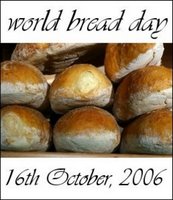 Zorra from Kochtopf is hosting a wonderful event that immediately got my attention. To help celebrate World Bread Day on the 16th of October she's asking us to either bake or buy bread and write a post about it. She even designed this great logo too!
Zorra from Kochtopf is hosting a wonderful event that immediately got my attention. To help celebrate World Bread Day on the 16th of October she's asking us to either bake or buy bread and write a post about it. She even designed this great logo too!Bread really is a universal constant in the world of food but for something so simple it's made in so many different ways. If you're a bread lover then mark this date in your calendar.
I'm hoping that between now and the 16th I'll have a few different breads made and I'm starting with a more usual bread.
This recipe comes from Let it Simmer by Sean Moran. The unusual ingredient in this bread is burghul. What's burghul you may be asking. It's this stuff on the spoon.
Cracked wheat is another name, though not entirely accurate - it can also be called bulgur, bulgar, bulger, bulghur or burghal. You'd probably be more accustomed to seeing it as part of Tabouli (or Tabbouleh).
Burghul is made from whole wheat kernels that are partially hulled. They are then soaked, steamed, dried and finally crushed. This crushed product is burghul. True cracked wheat has no soaking or steaming process - it's simply crushed wheat berries. It will take longer to cook than burghul, so if you use it, you need to factor in a longer cooking time.
Returning to the bread, this is probably one of the more "healthier" breads - it contains Spelt Flour (some information about Spelt can be found here), Wholemeal Flour, Oats and Burghul to create something that not only is good for you, but looks pretty good too.
Burghul Bread
(This makes 2 loafs - just halve the quantities to make one)
100 grams Burghul (or cracked wheat)
250ml water
½ teaspoon salt
2 teaspoons soft brown sugar
2 teaspoons dried yeast
50ml tepid water
½ cup sesame seeds
Dough:
750 grams Spelt flour (or unbleached baker's flour)
190 grams wholemeal plain flour
½ cup rolled oats (or unprocessed bran)
1½ tablespoons salt
50ml olive oil
400ml tepid water
Prepare the Burghul:
Bring the 250ml of water to boil in a saucepan and stir in the burghul and ½ teaspoon salt. Stir occasionally and allow it to simmer until the water is absorbed and the burghul has softened. This will take about 10-15 minutes. When cooked place it in a bowl and allow it to cool to room temperature.
Activate the yeast:
In a small bowl add the yeast, brown sugar and 50ml tepid water - whisk to combine and place in a warm spot for about 10 minutes or until it's foaming.
Make the dough:
Sift the flours into a large bowl then stir in the oats, followed by the softened burghul. Make a well in the centre of the mixture and add the activated yeast, olive oil, salt and water. Since all flours are different you may need to add more (or less) water than listed. Begin by adding 300mls and continue adding until the dough reaches the correct consistency.
For this dough I needed to add another 50mls.
If you don't want to do this by hand then use a stand mixer - I must say that this quantity proved to be a little too much for the Kitchenaid, so keep that in mind. If you make half the amount that should be fine.
Knead the dough until it's smooth and elastic - about 10-15 minutes. Form into a ball and place it in an oiled bowl covered with plastic wrap.
Leave in a warm spot to prove until doubled in size - about 1½ hours.
When risen, tip it out onto a board, cut in half and knead each half for about 5 minutes. Form into a long log shape.
Place the sesame seeds in a large dish and roll the dough into this - ensuring it's totally coated in seeds. Press the seeds against the dough to make sure they are stuck. Place this on baking paper and allow to rise again until doubled in size - about 1 hour.
Preheat your oven to 250°C/480°F
Finely mist warm water over the loaves before placing them in the oven and turn down the temperature to 200°C/390°F. Bake for 40-50 minutes or until the bread is golden brown and sounds hollow when tapped. If you feel they are browning too quickly, turn the oven down to 180°C/350°F.
Cool on wire racks.
This slices so very easily, the crust is crispy and thick, the core is wonderfully dense yet soft due to the effects of the burghul.
It's delicious eaten warm, thickly spread with honey.
Tagged with Bread


Your bread looks great! I'm anxious to see which will be your "World Bread Day-bread".
ReplyDeleteThank you very much for spreading the word!
that looks amazing. really!
ReplyDeleteThanks Zorra - there's so many different breads it's going to hard to decide.
ReplyDeleteThanks Anna!